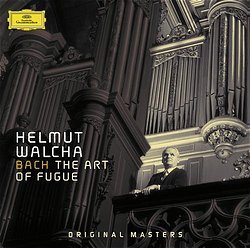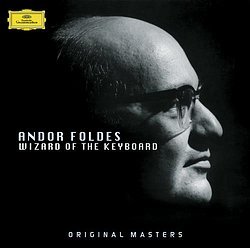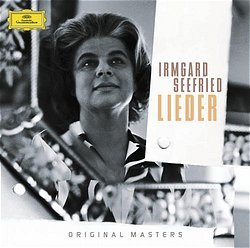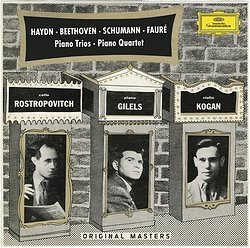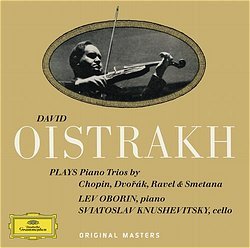Minuttens Original Masters Spotify tråd.
DAVID OISTRAKH
plays Piano Trios
Werke von / Works by Chopin · Dvorák Ravel · Smetana
Lev Oborin Sviatoslav Knushevitsky
CD |A|D|D| 000289 477 8537 8 |G|OM 2| 2 Compact Discs Original Masters
http://open.spotify.com/user/torbje/playlist/5vWTDgguvA7hdODeSv9BYn
A Golden Age of Collaboration
The Oborin-Oistrakh-Knushevitsky Trio
Although they won their greatest fame as soloists, Lev Oborin (1907-74), David Oistrakh (1908-74) and Sviatoslav Knushevitsky (1908-63) were dedicated players of chamber music. It gives great joy," Oistrakh wrote, not only to the listeners, but first of all to the performers themselves." He took part in several memorable ensembles with his friends: a sonata duo with Oborin, a piano quartet with Alexander Goldenweiser, Mikhail Terian and Knushevitsky, and a string quartet with Pyotr Bondarenko, Terian and Knushevitsky. All of these partnerships made superb recordings, but the most important of Oistrakh's chamber-music affiliations was the trio with Oborin and Knushevitsky. Listening to their surviving performances brings home to one that these musicians, players on an epic scale, could express themselves fully on smaller canvases as well. Although they could not help playing commandingly, each of them gave the impression of being a first among equals". They clearly listened to each other, rather than going their own way as can happen with a celebrity piano trio, and constantly moderated their playing to that of their colleagues. For Oborin, Oistrakh and Knushevitsky, chamber music was a warm-hearted conversation.
Oistrakh's first notable piano partner was the much older Goldenweiser, with whom he collaborated sporadically for some years; but his main sonata partner was Oborin. They first appeared together in Ankara in 1935, playing Grieg's C minor, and their duo endured for three decades. We take the utmost delight in every time we play together," Oistrakh said, whether in concert or during a rehearsal or in a quiet recording studio." In 1939 Oistrakh was teamed in the studio with one of his heroes, the pianist Konstantin Igumnov, and Knushevitsky, the leading Russian cellist of his generation, for a recording of the Tchaikovsky Trio which proved unsatisfactory. In 1941 another attempt was made, with Igumnov's pupil Oborin at the piano. Again it failed, for technical studio reasons, but the three got on so well that they formed a permanent ensemble which lasted for two decades. I remember the first years of our joint work," Oistrakh recalled. It was during the war. We met in a cold flat for a rehearsal. The first concert of our trio took place in the Tchaikovsky Hall at the beginning of 1942. We had to have a heating lamp close to our music stands so that we could warm our hands during the interval. We couldn't complete the concert: an air-raid alarm forced us to go down into the cellar."
This inauspicious beginning, amid the privations of wartime, contributed to the exceptional bond among the three great musicians. They were all virtually the same age: a year older than the other two, Oborin was the elder statesman, having begun his career early with his win at the 1927 Chopin Competition in Warsaw. Knushevitsky had a warm personality expressed in an individual, somewhat soft-grained tone. He was a sort of 'balance' in our trio that harmonized any opposing views when they occurred," Oistrakh wrote. His art 'cemented' the trio." A number of tours were undertaken; in fact their first post-war foreign visit was made as a trio, to Vienna in 1945. In 1947 Oistrakh played Shostakovich's Trio with the composer and the great Czech cellist Milo Sádlo at the Prague Spring and a studio recording was made, but otherwise the violinist was faithful to his regular colleagues. In 1953 the trio visited France and in 1958 Britain.
The Oborin-Oistrakh-Knushevitsky trio commanded three dozen works and, as the senior Soviet ensemble, recorded many of them (although the domestic catalogue also had to accommodate the Gilels-Kogan-Rostropovich group). They were the first star trio to set down the Beethoven Triple Concerto - their recordings, one from Moscow and one from London, remain touching memorials to Knushevitsky, who takes the leading role. No other trio has succeeded so well in walking the fine line between glibness and sentimentality in the two works by Mendelssohn. The Rachmaninov D minor was magnificently moody in their hands - Oborin was famed as a Rachmaninov pianist; in fact the Third Concerto, of which he made a superb recording, was his graduation piece. The Glinka and Rimsky-Korsakov Trios were made to sound like masterpieces and the two by Taneyev were fully realized. A successful studio performance of the Tchaikovsky was finally achieved in 1948 but not surprisingly was outdone by a live 1961 version - other fine concert recordings were the Schubert B flat, the delightful Hummel F major and the Shostakovich. Haydn's Trios nos. 27 and 28 were documented, the latter also surviving in a live performance. Oborin and Oistrakh were noted interpreters of the Beethoven violin sonatas and of course the trio featured this composer, leaving recordings of three works.
Turning to the four legendary interpretations included in this set, the Chopin G minor is superlative, perhaps the finest account of the work ever committed to disc. Apart from the glories of the string tone, it reminds us what a natural Chopin player Oborin was. The simplicity of the approach to the Ravel is refreshing - Oistrakh in particular had an affinity with French music, also to be heard in his renderings of Chausson's Poème, Debussy's Sonata and Ravel's Sonata and Tzigane. The Smetana and Dvoøák Trios (in addition, the group recorded the Dvoøák F minor) are excellent: all three men were welcome guests in Prague and counted Czech musicians among their friends, but Oistrakh had a special feeling for Czech rhythms and accents. There was, in truth, more Czech than Russian ancestry" in his violinistic make-up; and as a boy he had been deeply influenced by several of the Czech artists who worked in his native Odessa.
The death of Svet" Knushevitsky in February 1963 hit Oistrakh hard (The sound of his cello will always be in my ear") and more or less put paid to his chamber music activities, apart from duo recitals and domestic soirées. The great violinist was under pressure from all sides, as he was conducting as well as teaching and keeping up his solo career. The duo with Oborin came to a natural end as the pianist's health deteriorated, and in 1968 Oistrakh formed another partnership with Sviatoslav Richter. Although we have some fine chamber recordings from Oistrakh's last decade, the seventeen-or-so years after the war were a golden age of collaboration with like-minded friends, chief among them Oborin and Knushevitsky.
Tully Potter
6/2009



